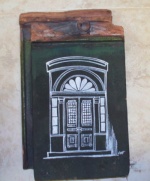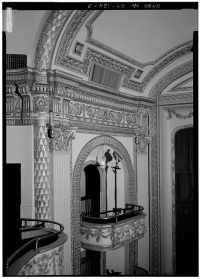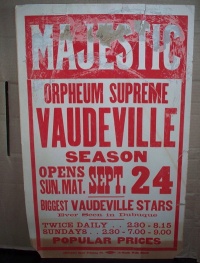Encyclopedia Dubuque
"Encyclopedia Dubuque is the online authority for all things Dubuque, written by the people who know the city best.”
Marshall Cohen—researcher and producer, CNN
Affiliated with the Local History Network of the State Historical Society of Iowa, and the Iowa Museum Association.
MAJESTIC THEATRE: Difference between revisions
No edit summary |
No edit summary |
||
| Line 45: | Line 45: | ||
[[Image:interior-3.jpg|left|thumb|200px|Interior view]] | [[Image:interior-3.jpg|left|thumb|200px|Interior view]] | ||
[[Image:bernhardt.jpg|right|thumb|200px|Famous talent was regularly "booked" to perform. Photo courtesy: Bob Reding]] | [[Image:bernhardt.jpg|right|thumb|200px|Famous talent was regularly "booked" to perform. Photo courtesy: Bob Reding]] | ||
[[Image: | [[Image:posterv.jpg|left|thumb|200px|Photo courtesy: Bob Reding]] | ||
Revision as of 02:03, 25 January 2018
MAJESTIC THEATER. The Majestic is the linear descendant of the ATHENAEUM, a theater constructed in 1840 in a building constructed in 1833 at the corner of Fourth and Main. The Athenaeum gave rise to an amazing list of theaters which could have ended on April 7, 1910 when fire destroyed the renovated BIJOU THEATER. Almost as the ashes were cooling, however, the site was developed as the first theater designed by the Chicago firm of C. W. Rapp and George Rapp, eventually the leading theater designers in the United States. (1)
The Majestic, built in 1910 at a cost of $90,000 in the style of Renaissance-Flemish architecture, was said to be a replica of the famous Moulin Rouge in Paris. (2) Immediately popular, the theater had forty shows booked by the end of construction. (3) The theater was said to have had an audience of 14,000 the week of November 18th when it opened--one third of the city's population. (4) Audiences were held in suspense as to what might be featured next. As early as November, 1910 Rosenthal presented "Vallecita's Leopards," billed as the most sensational animal act before the public today." (5) When "Amateur Nights" were featured with the six usual vaudeville numbers and a farce by the entire company, the curtain was raised at 8:15 p.m (6) Among the stars who appeared on its stage were Ethel Barrymore and Eddie Cantor.
Motion pictures were shown at the Majestic from the beginning. In December, 1910 it was announced that motion pictures would be seen at each and every live performance with pictures changed every Thursday and Sunday afternoon. (7) In June, 1917 the Telegraph-Herald featured a contest based on "Twenty Thousand Leagues Under the Sea." Interested children could clip a coupon from the newspaper and present it along with 15 cents to see the movie. When the movie was finished, they could write a short story on "What I Saw Through Captain Nemo's Submarine Window." Prizes were $5, $3, and $2. (8) Motion pictures and vaudeville ran as the regular bill until 1927 when a new feature was promoted--"Battle of Music." Two local orchestras were seated on platforms on the stage at the same time. One played a selection and then the other. At the conclusion, the audience judged which orchestra was the "hotter" and the recipient of a cash prize. The first "skirmish" features Bud and his Vioni Orchestra and Don and his Rag-Time Pals. When first announced on March 9, 1927 enough local orchestras had been lined up for six consecutive Friday nights. After the schedule was exhausted, the winner of each Friday night would meet in a grand tournament. The prize was a professional engagement at the Majestic in addition to a cash prize. It was suggested that an invitation might be extended to orchestras from outside Dubuque. (9)
The building was renamed "The Spensley" in 1929. (10) Its first program was a presentation of the talking motion picture, "Rio Rita," the "audifilm" version of the famous Ziegfeld musical success. (11) Jack Dempsey, former heavy-weight champion boxer of the world, and his vaudeville act "A Roadside Razz" appeared at the theater in 1930. (12) The famous Red Grange appeared in a musical on December 31, 1930. The stage was turned into a huge cooking school with demonstrations of "ranges, refrigerators, and other culinary equipment" in 1933. (13)
In 1932 even as the U.S. economy foundered, RKO, an American film production and distribution company, began buying up theater after theater to add to its exhibition chain. RKO was formed after the Keith-Albee-Orpheum (KAO) theater chains and Joseph P. Kennedy's Film Booking Offices of America (FBO) studio were brought together under the control of the Radio Corporation of America (RCA) in October 1928. The Dubuque theater, one of many purchased, became part of the RKO film theater circuit and was renamed the RKO ORPHEUM around 1934. (14)

---
Sources:
1. "Theater at Fourth and Main," Online: http://fiveflagscenter.com/AboutUs/History.aspx
2. "An Idea Whose Time Had Come," Telegraph Herald, March 22, 1979, p. 25
3. Voight, Sandye. "New-Look Five Flags Shines," Telegraph Herald, October 4, 2001, p. 11
4. "The Taste for Popular Amusements," The Dubuque Telegraph-Herald, November 29, 1910, p. 9
5. "Majestic," Dubuque Telegraph-Herald, November 287, 1910, p. 27
6. "Amateurs Tonight," Dubuque Telegraph-Herald, March 1, 1912, p. 11
7. "Majestic," Dubuque Telegraph-Herald, December 17, 1910, p. 13
8. "Children Begin Clipping Coupons For Greatest Undersea Picture," Dubuque Telegraph-Herald, June 28, 1917, p. 7
9. "Majestic Theatre Will be Scene of 'Battle of Music,'" Telegraph-Herald, March 9, 1927, p. 4
10. "Theater at Fourth and Main"
11. "New Spensley Open to the Public," Telegraph-Herald and Times Journal, November 17, 1929, p. 22
12. "Dempsey Comes Here Wednesday," Telegraph Herald and Times Journal, April 1, 1930, p. 5
13. "Make Spensley Theatre Ready for Cooking Demonstration," Telegraph Herald and Times Journal, Apr. 11, 1933, p. 5
14. "RKO Pictures," Wikipedia. Online: http://en.wikipedia.org/wiki/RKO_Pictures









